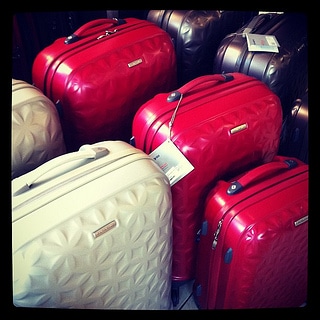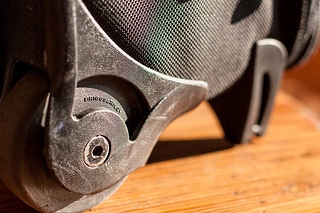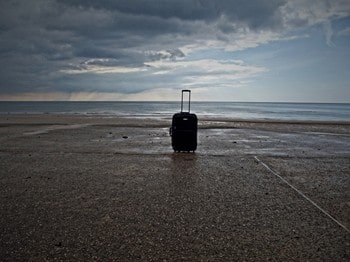What do you do when your luggage gets dirty or stained? Do you take it to a professional cleaner? Well, if you learn how to clean luggage yourself at home, you can save a lot of money and still keep it looking almost as good as new. So, here are some useful tips on how to take care of any type of luggage, whether it’s nylon, polyester, canvas, cotton, polycarbonate or leather.
Of course, you should take care of your luggage as much as possible so you won’t have to clean it as often. However, there are times when you won’t be in control of how your bags are handled, particularly if you check any bag for air travel or place them in a luggage hold any other time. Accidents can happen that can cause a stain to appear.
For storage, keep in mind these few simple tips. Frameless bags that are not foldable should be stuffed with rags or paper before storing to retain their shape. Leather bags should be stored in cotton bags or pillowcases. If your storage space allows it, try keeping softsided upright bags side by side instead of stacked on top of each other. Even better is if a smaller suitcase fits into a larger one, saving you lots of storage space. Place a packet of silica gel or a dryer sheet inside each bag to keep them dry and smelling fresh.
Before more rigorous cleaning, remove any detachable parts or lining and vacuum the suitcase’s or bag’s interior using the upholstery attachment. Hard surfaces, hinges and frames can be wiped clean with a damp cloth or Clorox wipe.
Many luggage brands come with specific instructions on how to care for their bags, but depending on the material used, there are some common methods and homemade cleaning solutions that work just as well for small stains and general upkeep. If you’re unsure about using any of these methods, just do a spot clean on any hard-to-see area first. Let’s take a look at the various cleaning methods now based on the material and type of luggage.
Table of Contents
- 1 How to Clean Polyester or Ballistic Nylon Luggage
- 2 How to Remove Mold and Mildew from Suitcases and Bags
- 3 How to Remove Stains from Luggage
- 4 How to Clean Polycarbonate Luggage
- 5 How to Clean Canvas Luggage
- 6 How to Clean Cotton Bags
- 7 How to Clean Leather Bags At Home
- 8 How to Clean Luggage Wheels and Hardware
- 9 How to Get Rid of Bad or Musty Odors
- 10 How to Clean Luggage From Bed Bugs
How to Clean Polyester or Ballistic Nylon Luggage
Polyester is easy to clean and Ballistic nylon gets its name from the tough Teflon treatment that repels most stains and dirt, so cleaning that is easy too. While some manufacturers recommend using a particular cleaner, most of the time you can skip it and just use a soft-bristled nylon brush dipped in a solution of warm water and mild soap. Clean the entire panel and not just the dirty spots. You can also use any upholstery cleaner that’s specifically meant for nylon or wool-nylon blend fabrics. Be careful not to use these cleaners on leather trim. Dry the bag completely in the shade before storing it.
How to Remove Mold and Mildew from Suitcases and Bags
If your soft sided luggage has been stored too long in a damp basement, chances are it will start to grow mold. To get rid of it, spray a solution of bleach and warm water over it. If it’s a fabric bag, you may not want the bleach causing the color to fade, so instead use a 1:1 solution of distilled white vinegar or rubbing alcohol. After a few minutes use a soft-bristled brush dipped in the solution and scrub the bag or suitcase all over and let it dry thoroughly (preferable in the sun) before using it. Some completely fabric or canvas bags can be dried in a dryer but check its label first.
How to Remove Stains from Luggage
For mild stains try using a mix of laundry detergent and water to spot clean the fabric. Tougher stains may benefit from an upholstery cleaner spray that you leave on for a few minutes and then you scrub off using a toothbrush or any soft-bristled brush.
If they’re wine stains from bottles that you checked in, first use any dry powder like baking soda, talcum powder, or table salt to absorb and lift any fresh from the fabric. After blotting the stain, apply either an oxi cleaner or 3 parts hydrogen peroxide and 1 part dishwashing liquid to the stain. Let it sit for 20 to 60 minutes, depending on how tough the stain is, and blot dry or wipe off with a clean damp cloth.
How to Clean Polycarbonate Luggage
 Hardside luggage, especially polycarbonate, is becoming popular again but one of the main complaints that users have with is that they show the dirt and scratches very easily. Therefore try to handle all hardside luggage yourself, unless it is a checked bag.
Hardside luggage, especially polycarbonate, is becoming popular again but one of the main complaints that users have with is that they show the dirt and scratches very easily. Therefore try to handle all hardside luggage yourself, unless it is a checked bag.
Once your polycarbonate bag does get dirty from regular use, use a washcloth dipped in a very mild solution of warm water and dish washing soap to clean it. Clean the entire shell of the suitcase with this solution and not just the dirty spots. Next use a plain damp cloth to wipe off any soap residue, followed by a completely dry cloth to leave the shell clean and shiny. Do not leave any moisture behind or the stain will be visible.
If your polycarbonate or other hardsided luggage is showing scuff marks, use an eraser cleaning pad or even toothpaste with an abrasive sponge to scrub away and buff the area. Finish off by wiping the residue away with a dry cloth.
How to Clean Canvas Luggage
For light oil stains or soil, rub dry baking soda on the area and work it in with an old toothbrush. Use another toothbrush to clean off the residue. If the dirt is still showing, mix about 3-4 tablespoons of baking soda in a cup of water and rub it in with a damp cloth. If it’s a stubborn stain, try using a mix of laundry detergent and water on the spot.
If you use either of the two wet methods, don’t get the canvas too wet and dry the bag immediately with a hand held dryer.
Many canvas bags can be machine washed, so check the tag to see if that’s possible for general cleaning.
How to Clean Cotton Bags
100% cotton bags with no trim, rigid base or quilting can usually be machine washed unless the tag says otherwise. Otherwise, just spot clean with laundry detergent and water. Lay the bag flat to dry.
How to Clean Leather Bags At Home
 Most people think that cleaning an expensive leather bag by yourself is a mistake but it’s not. You can do general cleaning as well as removal of minor stains at home and take the bag to a professional leather cleaner only for difficult stains. With all of the following cleaning methods, make sure to follow up with a good leather conditioner to protect your bag from future stains and dirt and keep the leather beautiful and shiny.
Most people think that cleaning an expensive leather bag by yourself is a mistake but it’s not. You can do general cleaning as well as removal of minor stains at home and take the bag to a professional leather cleaner only for difficult stains. With all of the following cleaning methods, make sure to follow up with a good leather conditioner to protect your bag from future stains and dirt and keep the leather beautiful and shiny.
For an easy way to always keep your bag looking new, regularly wipe it down with alcohol-free baby wipes and then immediately dry it with a soft towel or microfiber cloth.
When it’s time for a more thorough cleaning, use a good leather cleaner (could be manufacturer recommended). Instead of spraying the cleaner directly onto the bag, take a damp cloth and dip a corner into it. Apply the cleaner on a section and work up a lather. Repeat until you cover the the whole bag but be careful to not get the leather too wet. Dry it off thoroughly with a dry cloth. To ensure that the cleaner doesn’t sit on the bag too long, try cleaning and drying small areas at a time. Finish it up with a the protective leather conditioner.
Next comes stain removal. If it’s a water stain, take a slightly damp microfiber cloth and dip a corner into a mild liquid soap like Neutrogena or Dove and slowly rub it into the water stain using circular motions. Try to stay within the stain. After you do that for about a minute, take a clean part of your damp cloth and wipe the area off. Wait for a day to air dry and repeat if the stain is not completely gone. End with an application of leather conditioner.
If your carry pens in your bag or just accidentally nick the leather with an ink pen, take a cotton ball and wet it with rubbing alcohol. Gently apply it to just the stain. It will come right off and you may see a little bit of the color coming off onto the cotton ball as well. Don’t worry about it, as that will not show once you use the leather conditioner afterwards.
For small oil based stains, like from food spills, first remove as much of the dirt as possible with a dry cloth. Then take a pinch of cornstarch and apply it to the stain. Let it sit for about 15 minutes to allow it to draw out the oil. Next take an old toothbrush and gently but thoroughly work the cornstarch into the leather. Brush it off when you’re done and wipe off completely with a dry cloth.
Here’s a detailed video that shows you how to remove stains from leather bags.
How to Clean Luggage Wheels and Hardware
 Luggage wheels are the parts that get the dirtiest for obvious reasons. To keep them rolling smoothly, remove any dried soil and loose dirt from them before wiping them down with a soap and water solution. There’s no need to lubricate them if they’re maintained regularly.
Luggage wheels are the parts that get the dirtiest for obvious reasons. To keep them rolling smoothly, remove any dried soil and loose dirt from them before wiping them down with a soap and water solution. There’s no need to lubricate them if they’re maintained regularly.
For the hardware or solid accessories on your bags, i.e. telescopic handle, zippers, locks and protective edges and bumpers, never use any kind of oil based cleaner as the oil can seep into the fabric or shell of the bag and stain it. Wipe down with soap and water and dry. If there are scratches, buff the area with a fine steel wool scrubber and seal with a protective coat of lacquer or even clear nail polish.
How to Get Rid of Bad or Musty Odors
Sprinkle dry baking soda all over the inside and outside of the bag and leave it for an hour or more, then vacuum it out. If the odor is still around, mix half a cup of lemon juice with half a cup of water and spray it all over the bag. Let it dry naturally in an area not directly under sunlight.
How to Clean Luggage From Bed Bugs
If you are unlucky enough to get bedbugs in your luggage, first spray the bag with 91% isopropyl alcohol to kill them on contact. Once they’re dead, vacuum out the entire bag, including the crevices.
So there you have it – simple methods on how to clean luggage of any kind!
All images from the public domain except for: © Jorge Royan / https://www.royan.com.ar / CC-BY-SA-3.0
Rossetti Borse by simbiosc, on Flickr


I purchased this suitcase in 2014 and used it to travel on a cruise. When my suitcase was brought to my room it had a blackish stain on the outside. I’m not sure what the material type is, but I tried to spot clean it with tide laundry detergent. It did not come out.
How can I clean this suitcase? The London Fog suitcase brownish in olive plaid houndstooth in color. Copy & paste the website below to see the product.
If a soft bristle brush dipped in water and mild detergent doesn’t work, try using an upholstery cleaner meant for nylon fabrics. Failing that, the manufacturer may have mentioned a specific cleaner to use somewhere on the documentation.
I have three large pieces of luggage (nylon covered) that when I stored them in my new rental basement. They became covered with mold! help, How do I clean them????????????/
The best way to get rid of mold is to use a mixture of bleach and warm water. Scrub the luggage with a brush dipped in the solution. Dry the pieces fully once cleaned.
Here’s a fail-safe method for removing minor scuffs and airline stains on soft luggage (e.g. ballistic nylon). Takes ~15 min labor per bag, but 1-2 days total (to dry).
Mix common dish detergent (e.g. Dawn) with hydrogen peroxide from the drug store…about 2 tblsp soap plus 1/2 cup hydrogen peroxide (proportions not terribly critical), no water. Apply with stiff brush (e.g. a dish brush) to entire suitcase exterior. Work up a good lather. Let the bag sit 10-30 min. Then spray thoroughly with garden hose, brushing if you like to help rinse out soap. Yes, bag will get thoroughly wet! Probably won’t get all soap out. Don’t worry. Now set bag out in sun to dry. Open (unzip) all compartments. Stuff paper (e.g. newspaper) loosely in unzipped outside pockets to help keep them open for drying. Takes 1-2 days to dry, but my 3-4 yr old Victorinox case looks like this year’s model, despite multiple international trips to Europe and Asia!
Thanks for the detailed instructions, Steve!
My wife’s carry on bag has a substance on the bottom of it that looks like white crystals. She has cleaned it twice but after a few months it comes back. Any idea how to get rid of it permanently?
It could be a white mold problem where the spores haven’t been completely eliminated. Try one or both of these methods: Hand vacuum the bag with a soft bristle brush. Or, use a 1:1 solution of white vinegar and clean water to scrub the surface and then dry thoroughly in front of a fan. Make sure the storage space for the bag is not damp and air the bag out once a month.
Thank you for the advice. Do you rinse the vinegar solution once the bag is scrubbed or just let it dry?
Wipe it with a damp cloth after scrubbing just to get rid of residue.
What is the best way to clean the wheels of a rolling backpack? I pick up a lot of hair from the crazy teens I work with at a junior high.
I’d first try with a pair of tweezers, screwdriver or the bottle opener of a Swiss army knife to remove the hair. If that doesn’t work, try lighting a match to burn the hair. Just a quick singe is enough so as to not damage the wheels. Once it’s all gone, soapy water to clean it all up.
Hi. Thank you for all the great help. The problems I have are with a following back pack but looks more like suitcase. It’s a beautiful red. Somehow a heavy black grease substance is on one side of suitcase affecting both wheels. I am so worried that I can’t clean it! I really like it! Any help is greatly appreciated! Thanks kindly, Becky
I’m not sure if I understood correctly – the grease stain is on the fabric of the bag or on the wheels? This is what I would do… First scrape off any residue that you can, then use equal parts dishwashing liquid soap and water to cover the stain and scrub that with a toothbrush. Wipe off with a damp cloth. If the stain is already deep set in the fabric, try a little spray of WD-40 and then wash it off. good luck!
Cameback from a trip and discovered garlic oil spilled in my canvas luggage. Have used lemon and water, covered it in dryer sheets to no avail.
Help pls
Try this: Use a solution of hot water and ideally a colorless dishwashing soap. Cover the stain in the solution and using an old, clean toothbrush, brush gently in circular motions to rub the soap into the stain. Wipe off residue with a damp cloth and dry with a blow dryer. Let me know if it helps.
Sorry for not replying sooner. Went on a vacation and before leaving did as you instructed. Came back and my luggage still smells.
I’m afraid that the smell might only go slowly if you leave the luggage out in the sun for a while. It’s harder to get rid off.
Something leaked inside my suitcase and the non-removeable liner has large brown stains and a funky smell. Any suggestions? Tnx
The only way to find out if it’s permanent is to use clean it up and air the bag out in the sun, I’m afraid. Try one of the methods here or in the comments
Hi. I have a Caribee Fast Track 75 and recently went on a trip and the airline managed to cover it in oil whilst in the hold. It was blue in colour but now has black oil patches over most of the front and back. I think it is ballistic nylon but not sure. What is the best way to try and remove this? Regards. Mick
It is a nylon bag so I would suggest using a nylon-bristled brush and a solution of cold water and a few squirts of dish washing soap. Wipe with a damp cloth to remove any residue and leave it to dry
I have a Tegra Light Suitcase, on returning from a trip my wife covered the suitcases with heavy plastic to keep them safe but now there are ugly moisture stains on the suitcase, I assume from humidity .
Does anyone know how to get rid of them .
Thanks
You could try cleaning it gently using warm water with a few drops of liquid detergent and a microfibre cloth. Tumi’s Tegris material is thermoplastic polypropylene. If that doesn’t work, the best thing to do would be to contact Tumi for advice.
My vintage Hartman luggage has a rust problem on the hardware inside the bags…the latches, snaps. clips. I brushed the hinges etc with a steel brush then applied a rust treatment (Ospho). I dont know what else to do. Can this rust be removed from these brass (I think) pieces?
Try creating a paste of equal parts flour, salt, and vinegar and apply that in a thin layer. Let it sit for about an hour. Rinse with water and dry.